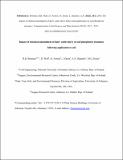The impact of chemical amendment of dairy cattle slurry before land application on soil phosphorus dynamics
Date
2014-08-22Author
Brennan, Raymond B.
Healy, Mark G.
Metadata
Show full item recordUsage
This item's downloads: 418 (view details)
Cited 11 times in Scopus (view citations)
Recommended Citation
Brennan, R.B., Wall, D., Fenton, O., Grant, J., Sharpley, A.N., Healy, M.G. (2014) 'The impact of chemical amendment of dairy cattle slurry before land application on soil phosphorus dynamics'. Communications In Soil Science And Plant Analysis, 45 (16):2215-2233.
Published Version
Abstract
Application of dairy cattle slurry to agricultural soils, particularly those with high phosphorus (P) status or vulnerability to runoff, can increase P loss to waterbodies, which may accelerate eutrophication. While the effectiveness of P stabilizing amendments added to slurry or soil for reducing incidental P losses is well established, their effectiveness in reducing chronic (long-term) P losses is not as well known. Five soils (4 mineral and 1 organic) were selected to represent the range of chemical and physical properties typically found in agricultural soils in Ireland, and a 9-mo incubation study was conducted to investigate the effectiveness of amending dairy cattle slurry with either alum, lime, poly-aluminum chloride (PAC), or ferric chloride (FeCl3), in reducing water extractable P (WEP) levels in the soils. Alum, lime, and PAC were the most effective amendments in decreasing WEP (compared to a slurry-control) for the four mineral soils (up to 97% 1 mo after application and by an average of 47% at the end the 9-mo incubation period). In comparison, FeCl3 increased WEP (compared to the slurry-control) by an average of 35% at the end the study. None of the amendments examined effectively reduced WEP of the organic soil. No amendment reduced soil test P (Morgan s P (Pm) and Mehlich-3 P (M3P)) compared to the soil-only treatment. Therefore, amendment of dairy cattle slurry with alum, lime, and PAC can reduce the risk of chronic P loss in mineral soils without decreasing plant available P. Alum maintained the highest levels of M3P across the 4 mineral soils with the least risk of P loss to overlying water. With the exception of the soil-only treatment, there were significant positive relationships (p<0.05) between M3P and WEP for each treatment. Further work across a wider range of soil types and drainage regimes is required before recommendations can be made to farmers or catchment managers.
Description
Journal article


